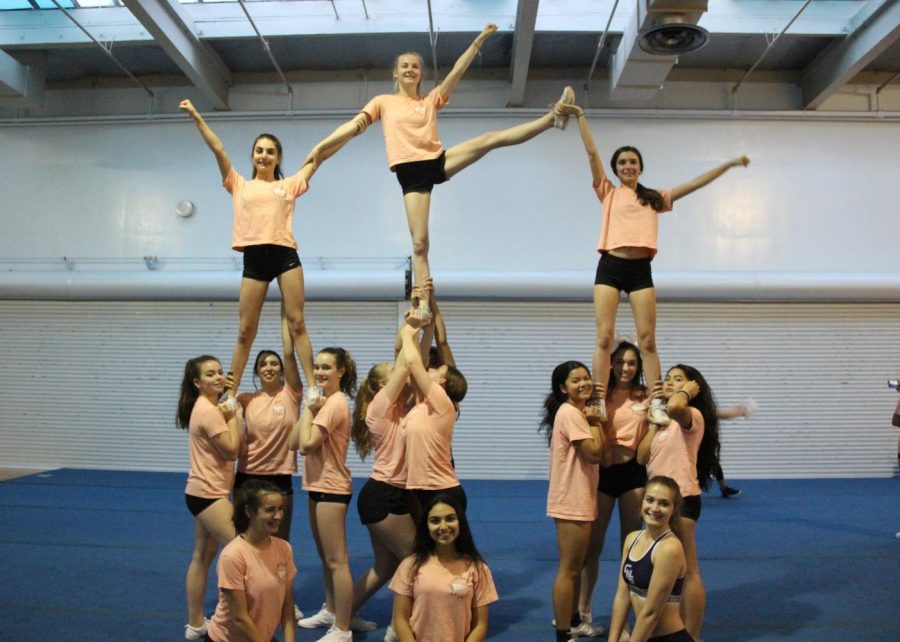The athletes lined up, ready to bring their flyers toward the sky. They began to count off.
“One, three, five, seven.”
The flyers jumped into their bases’ hands and were pushed straight up into the air. Their bases’ arms were locked, and everyone was concentrated on keeping the flyers steady in the pyramid, the most complicated stunt of their routine.
However, as the arms of the flyers connected, they began to wobble, and soon enough, they cascaded down.
With linked arms, not one, but two of the flyers fell. The center group lost their balance, sending flyers Sophia Morgan, a sophomore, and Maya Brazil, a freshman, tumbling downward.
Morgan was barely caught by her teammates below, inches before hitting the ground. One of her bases, freshman Alexia Stevenson was knocked down, smacking her head on the AstroTurf.
“When it first happened, I felt very confused and scared because I didn’t know what was going to happen and if I actually had a concussion,” Stevenson said.
This thought was going through the heads of many of the cheerleaders that day.
As Brazil fell, her entire stunt group fell with her. In the end, four cheerleaders were piled on top of one another, their heads throbbing, uncertain of possible head trauma they may have incurred.
This would be Brazil’s second concussion within three weeks.
From the crowd’s point of view, Carlmont cheerleaders mainly perform dances and cheers; however, there is a lot more work that goes into the sport, work that can only be seen during practices. Most of this time is put towards learning and perfecting new stunts to be put into routines for each game or assembly at which they perform.
Stunts are building performances in which two base cheerleaders and one back spot cheerleader lift or toss a flyer into the air. Each set of two bases, one back spot, and one flyer is called a stunt group.
Without knowing the technicalities of stunts, the audience comes away without a sense of the effort put into the performance.
“When spectators watch our stunts from afar, they do not seem difficult because the team has perfected it and made it look effortless,” said the head coach of Carlmont’s varsity cheer team, Kalina Wasman.
Although concussions are prominent in cheerleading, with all the work put into stunting, there are a lot of other injuries that are possible as well. The cheer team is cautious in regards to stunting, but the drive to perfect a stunt sometimes gets in the way of safety.
“Many people do not understand the hard work and dedication that goes into cheerleading. Cheerleaders are expected to learn and perfect many difficult skills and be able to perform them after only a couple of practices. Just like any other sport, cheerleading is a huge commitment, and it takes a lot of hard work to improve,” said Lauri Lottice, a retired professional cheerleader for the San Francisco 49ers.
Concussions, one of the seemingly common injuries in cheerleaders, are mild traumatic brain injuries that occur from an impact causing your brain to shake quickly back and forth. The symptoms include headaches, vomiting, confusion, and even loss of consciousness.
However, these symptoms seem minor in comparison to the long-term effects that can result from concussions. Such effects include the inability to concentrate for extended periods of time, difficulty reading and writing, and, in most severe cases, loss of memory.
“You can have long term problems with IQ, memory, emotional problems, and headaches,” neuroscientist Dr. Sarah Cheyette said.
However, there are more downsides to concussions than just physical trauma.
“When I got hurt, I was really worried about what the outcome would be. All I could think about was how long I would be unable to perform. The second time I got a concussion, I was much more worried given how close in time it was to Homecoming. I was set on performing, and when I discovered I was unable to, I was really disappointed,” Brazil said.
Another cheerleader injured during the previous incident was Emily Hall, a freshman. She was a base and one of the four cheerleaders that fell.
“The experience of having a concussion has affected me a lot because even now, a month after getting it, I am very headache prone, and I am a little scared of stunting in pyramids,” Hall said.
JV cheer is a new team at Carlmont this year and had never experienced such a large accident. In contrast, varsity cheer has had to overcome similar incidents in the past.
“When someone on my team gets injured, it’s upsetting, as no one likes seeing them hurt. It also forces our team to have to change every part of the routine that involved the injured cheerleader. This is very difficult, especially if we don’t have a lot of time,” said Larissa McCord, a senior on varsity cheer. “Still, in the end, it works out and allows our team to come together and grow.”
Ultimately, the long hours and possible injuries that come hand-in-hand with the sport do little to deter the athletes’ appreciation for the program. According to Wasman, they hope that, like the program, the audience’s respect for the sport will continue to grow.
“I do not think many people understand the hard work and practice that goes into cheer considering how physically and mentally difficult it is to put together a routine. Cheer is a lot more than shaking pom-poms and I think people should know that,” Hall said.
























